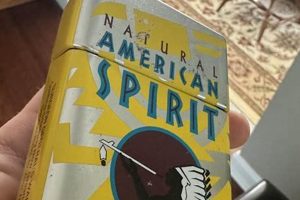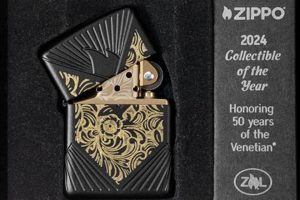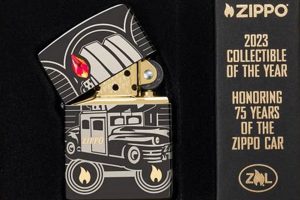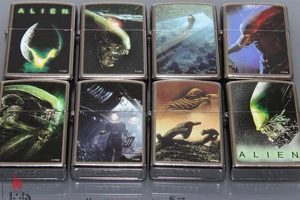Assembling an assortment of Zippo lighters is a popular hobby, often focusing on specific themes, designs, or historical periods. For example, a collector might concentrate on lighters commemorating military events, showcasing artistic designs, or representing advertising campaigns.
The practice provides a tangible link to history, design, and popular culture. These pocket-sized pieces often reflect broader social trends, technological advancements, and artistic movements. Building such an assemblage offers opportunities for research, community engagement with other enthusiasts, and the satisfaction of preserving artifacts of material culture. The potential investment value of specific rare or historically significant pieces adds another dimension to the pursuit.
This exploration will delve into various facets of acquiring, preserving, and appreciating these miniature metal canvases, covering topics such as identifying valuable pieces, proper storage techniques, and the rich historical narrative embedded within each lighter.
Tips for Building a Meaningful Lighter Collection
Building a substantial and rewarding collection requires careful consideration and strategic planning. The following tips offer guidance for navigating the nuances of acquiring, preserving, and appreciating these miniature artifacts.
Tip 1: Focus on a Theme: A defined collecting area, such as a specific historical period, brand, or design style, provides focus and prevents haphazard accumulation.
Tip 2: Research Thoroughly: Knowledge of manufacturing dates, design variations, and historical context is crucial for informed acquisitions.
Tip 3: Authenticate Carefully: Counterfeit items exist. Scrutinize details like markings, construction, and materials to ensure authenticity.
Tip 4: Inspect for Condition: Assess the lighter’s physical state, noting any scratches, dents, or missing parts. Condition significantly impacts value.
Tip 5: Store Properly: Protect lighters from humidity, extreme temperatures, and direct sunlight to prevent damage and preserve value.
Tip 6: Connect With Other Enthusiasts: Joining collector communities provides access to valuable knowledge, resources, and potential trading opportunities.
Tip 7: Document Meticulously: Maintain detailed records of each acquisition, including provenance, condition, and purchase price.
By adhering to these guidelines, one can cultivate a collection that is not only personally rewarding but also historically significant and potentially valuable.
These practical tips offer a strong foundation for embarking on the rewarding journey of building a meaningful and valuable collection. The subsequent sections will delve further into specific areas, providing additional insights for both novice and experienced collectors.
1. Acquisition
Acquisition forms the cornerstone of any collection. Within the realm of Zippo lighters, the process of acquiring new pieces involves a multifaceted approach. Strategic acquisition hinges on several factors: identifying target pieces based on specific collecting goals (e.g., a particular era, design, or theme); understanding market values and pricing; selecting reputable sources, including auctions, specialized dealers, online marketplaces, and private collectors; and exercising due diligence in verifying authenticity and condition. For example, acquiring a limited-edition commemorative lighter might involve monitoring online auction platforms, comparing prices offered by various sellers, and scrutinizing images and descriptions for signs of wear or damage. The acquisition process often involves negotiation and careful decision-making to ensure value and alignment with collecting objectives.
The method of acquisition can significantly impact the overall cost and potential investment value. Direct purchases from reputable dealers often provide assurance of authenticity but may come at a premium. Online marketplaces offer wider availability and potential bargains but necessitate greater vigilance in verifying legitimacy and condition. Participating in specialized auctions can offer access to rare and sought-after pieces, but competitive bidding can drive up prices. Careful consideration of these factors is essential for informed acquisition practices. Successfully acquiring a desirable piece, such as a rare wartime lighter in pristine condition, often requires patience, persistence, and a deep understanding of the market.
Strategic acquisition contributes directly to the growth, value, and focus of a collection. The choices made during this process shape the narrative and significance of the assemblage. Challenges include navigating fluctuating market prices, identifying reputable sources, and avoiding counterfeit items. Overcoming these challenges requires knowledge, vigilance, and a discerning eye. Ultimately, successful acquisition practices contribute to the overall satisfaction and historical value of the collection.
2. Preservation
Preservation is paramount within a Zippo collection, directly impacting both the longevity and value of individual lighters and the assemblage as a whole. Environmental factors, such as humidity, extreme temperatures, and direct sunlight, can cause metal degradation, finish deterioration, and mechanical malfunction. Improper handling can lead to scratches, dents, and diminished functionality. For example, storing lighters in a humid environment can lead to corrosion, significantly impacting their aesthetic appeal and potentially rendering them unusable. Conversely, meticulous preservation maintains a lighter’s condition, safeguarding its value and historical integrity.
Effective preservation strategies encompass appropriate storage solutions and careful handling practices. Utilizing specialized display cases with protective linings safeguards against environmental damage. Handling lighters with clean hands minimizes the risk of transferring oils and contaminants that can accelerate deterioration. Storing lighters in individual protective pouches prevents scratches and minimizes friction. For instance, a rare, vintage Zippo with an original high-polish chrome finish, if stored correctly in a controlled environment, can retain its pristine condition for decades, preserving its historical value and enhancing its collectibility.
The significance of preservation extends beyond individual pieces, contributing to the overall historical and financial value of the collection. A well-preserved collection maintains its integrity, providing a tangible link to specific eras, design aesthetics, and manufacturing techniques. This preservation also safeguards the investment potential of individual lighters and the collection as a whole. Preservation challenges include maintaining stable storage environments, especially in fluctuating climates, and resisting the temptation to handle frequently displayed pieces. Addressing these challenges through proactive measures ensures the lasting value and historical significance of the collection.
3. Authentication
Authentication plays a critical role in Zippo collecting, ensuring the integrity and value of a collection. Counterfeit lighters exist within the market, posing a significant risk to collectors. Distinguishing genuine Zippos from replicas requires careful examination and knowledge of specific manufacturing details, including bottom stamps, case markings, insert construction, and overall finish quality. For example, authenticating a vintage wartime Zippo involves verifying the date code stamped on the bottom, analyzing the specific features of the lighter’s insert, and comparing the patina and wear patterns with known genuine examples. Failure to authenticate can lead to inadvertent acquisition of counterfeit items, diminishing the historical value and financial investment of a collection.
Several resources aid in the authentication process. Specialized guides and online forums offer detailed information on identifying genuine Zippo markings and construction characteristics. Consulting with experienced collectors and reputable dealers provides expert opinions and validation. Comparing a potential acquisition against documented authentic examples can help reveal discrepancies that indicate a counterfeit. For instance, a suspected counterfeit might exhibit inconsistencies in the bottom stamp font, incorrect placement of markings on the insert, or an overall finish quality that deviates from genuine Zippo standards. Employing these authentication techniques protects collectors from fraudulent items and ensures the legitimacy of their acquisitions.
The ability to authenticate Zippo lighters directly impacts a collection’s value and historical significance. A collection comprised of verifiably genuine pieces holds greater historical weight and commands higher market prices. The authentication process, while challenging, is crucial for maintaining the integrity of the collection. Challenges include the increasing sophistication of counterfeiters and the subtle variations in genuine Zippo production over time. Overcoming these challenges requires continuous learning, reliance on reputable resources, and a discerning eye for detail. Ultimately, rigorous authentication practices safeguard the collection’s value, historical accuracy, and the collector’s reputation within the community.
4. Cataloging
Cataloging is essential for managing and appreciating a Zippo collection. A well-maintained catalog provides a structured record of each lighter, facilitating organization, research, and valuation. It transforms a collection from a mere assortment of items into a curated assemblage with documented provenance and historical context. This systematic approach enhances both the practical management and the intellectual engagement with the collection.
- Detailed Descriptions
Each entry should include a comprehensive description of the lighter, encompassing model, finish, design, date code, and any unique features. For example, a catalog entry might describe a lighter as a “1942 WWII brass Zippo, windproof lighter, featuring a patriotic eagle emblem, with a visible bottom stamp ‘A XIV.'” Such detailed descriptions allow for easy identification and comparison within the collection, assisting in research and potential valuation.
- Provenance Tracking
Documenting the acquisition history of each lighter, including the source (e.g., auction, dealer, private collector), date of purchase, and purchase price, adds another layer of depth to the catalog. Knowing a lighter’s provenance enhances its historical significance and can influence its value. For instance, a lighter acquired directly from a veteran’s estate holds greater historical value than one purchased from a general antique store.
- Condition Assessment
Noting the condition of each lighter at the time of acquisition and periodically thereafter is crucial. This includes documenting any existing wear, scratches, dents, or mechanical issues. Tracking condition changes over time informs preservation efforts and provides a valuable record for insurance purposes. A lighter’s condition directly impacts its value; therefore, accurate and consistent documentation is essential.
- Digital Cataloging Methods
Utilizing digital tools, such as spreadsheets or specialized collecting software, offers several advantages. Digital catalogs allow for easy searching, sorting, and updating of information. They also facilitate the inclusion of images and links to external resources, enriching the catalog and providing a comprehensive digital record. For instance, incorporating high-resolution photographs of each lighter in a digital catalog enhances visual documentation and aids in identification.
These facets of cataloging, when combined, create a comprehensive and valuable resource for managing and understanding a Zippo collection. A meticulously maintained catalog not only simplifies the practical aspects of collection management but also elevates the collecting experience by providing deeper historical context, facilitating research, and safeguarding the collection’s long-term value and historical significance.
5. Display
Displaying a Zippo collection transforms accumulated objects into a curated presentation, allowing for both personal appreciation and shared engagement with the historical and artistic narratives embedded within each lighter. Effective display methods highlight the collection’s thematic focus, the individual lighters’ aesthetic qualities, and their historical significance. Consider a collection focused on Zippos from the 1950s: displaying them in a period-appropriate cabinet, alongside related ephemera like vintage advertisements, enhances the overall presentation and contextualizes the lighters within their historical milieu. Conversely, haphazard storage diminishes the collection’s impact, reducing it to a mere accumulation of objects.
Various display options cater to different collecting styles and available space. Dedicated display cases offer organized and protected environments, often incorporating features like adjustable shelving, integrated lighting, and UV protection to safeguard against fading and deterioration. Thematic arrangements within these cases, such as grouping lighters by era, design, or material, enhance visual coherence and narrative impact. Wall-mounted displays provide space-saving alternatives for showcasing select pieces, allowing for regular rotation and creating focal points within a room. Integrating descriptive labels or accompanying historical information enriches the display, transforming it into an educational exhibit. For example, a display case featuring Zippos from different military conflicts, accompanied by brief descriptions of each lighter’s historical context, enhances the viewers’ understanding and appreciation of the collection.
The choice of display method directly influences the collection’s perceived value and the owner’s engagement with it. A well-considered display enhances the aesthetic appeal of individual lighters, reinforces the collection’s thematic focus, and provides a platform for sharing the historical narratives embedded within these miniature artifacts. Challenges include balancing aesthetic considerations with preservation requirements, managing space constraints, and preventing accidental damage from handling or environmental factors. Addressing these challenges through strategic planning, appropriate materials selection, and diligent maintenance ensures that the display enhances, rather than detracts from, the collection’s overall significance and value.
6. Research
Research forms an integral component of building a meaningful and valuable Zippo collection. It provides the foundation for informed acquisitions, accurate authentication, and a deeper appreciation of the historical and cultural significance embedded within each lighter. Through diligent research, collectors transform a simple accumulation of objects into a curated assemblage that tells a story.
- Manufacturing Dates and Variations
Understanding Zippo manufacturing processes and variations across different periods is crucial. Researching date codes, production techniques, and material changes allows collectors to accurately identify specific models and assess their historical context. For example, recognizing the subtle differences between wartime and post-war brass casings allows for accurate dating and informs valuation. This knowledge empowers collectors to make informed decisions during acquisition and enhances their ability to authenticate potentially valuable pieces.
- Historical Context and Significance
Researching the historical context surrounding specific Zippo designs significantly enhances their meaning. Investigating wartime production, commemorative editions, and advertising campaigns provides insights into the social, cultural, and political landscapes that influenced these designs. For instance, understanding the symbolism behind a specific military insignia on a wartime Zippo connects the object to a broader historical narrative, deepening its significance within the collection.
- Market Values and Trends
Researching current market values and trends is crucial for making sound investment decisions. Understanding pricing fluctuations, identifying rare or sought-after models, and recognizing factors that influence value, such as condition and provenance, empowers collectors to make informed purchases and potentially maximize the long-term value of their collections. For example, tracking auction results for specific rare Zippo models informs bidding strategies and helps avoid overpaying for acquisitions.
- Connecting with the Collector Community
Engaging with online forums, specialized publications, and collector groups provides access to invaluable shared knowledge and resources. Connecting with experienced collectors offers opportunities for learning, exchanging information, and verifying the authenticity of potential acquisitions. Participating in these communities enhances the collecting experience and contributes to a deeper understanding of the nuances within the field.
These facets of research, when integrated into the collecting process, transform a Zippo collection from a simple accumulation of objects into a curated historical narrative. The knowledge gained through research informs acquisition strategies, enhances authentication efforts, and enriches the overall appreciation for the historical and cultural significance embodied within each lighter. This dedication to research elevates the collection beyond mere ownership to a deeper engagement with history, design, and material culture.
7. Community
The community aspect of Zippo collecting extends beyond individual pursuits, fostering connections among enthusiasts who share a passion for these miniature metal canvases. This network of collectors provides a valuable platform for exchanging knowledge, sharing discoveries, and supporting fellow enthusiasts. Engaging with this community enriches the collecting experience, offering access to a wealth of information and camaraderie.
- Shared Knowledge and Expertise
Collector communities offer a vast repository of shared knowledge. Experienced collectors often possess specialized expertise in specific areas, such as wartime Zippos, rare models, or authentication techniques. This collective expertise becomes accessible through online forums, dedicated websites, and in-person gatherings, providing invaluable resources for both novice and seasoned collectors. For example, a collector seeking information on a rare 1930s model can tap into the community’s collective knowledge to gain insights into its historical significance, market value, and identifying features.
- Trading and Acquisition Opportunities
Collector communities facilitate trading and acquisition opportunities. Collectors often seek specific pieces to complete thematic collections or acquire rare examples. Connecting with fellow enthusiasts creates a marketplace for exchanging lighters, expanding collections strategically, and acquiring pieces that might otherwise be difficult to find. This network of collectors allows for direct transactions, often bypassing traditional retail channels, potentially offering better pricing and access to unique items.
- Authentication and Preservation Support
The community provides crucial support for authentication and preservation efforts. Experienced collectors can offer guidance on verifying the authenticity of questionable pieces, sharing insights into identifying counterfeit markers and confirming genuine characteristics. The community also provides a platform for exchanging preservation best practices, recommending storage solutions, and sharing tips for maintaining a lighter’s condition. This collective knowledge helps safeguard the integrity and value of individual collections and the hobby as a whole.
- Showcasing and Celebrating Collections
Collector communities provide opportunities for showcasing and celebrating individual collections. Online forums and in-person gatherings offer platforms for sharing curated displays, discussing specific pieces, and engaging in friendly competition. This shared appreciation fosters a sense of camaraderie and encourages continued engagement within the hobby. Showcasing collections allows individuals to share their passion, receive feedback from peers, and contribute to the collective knowledge within the community.
These interconnected facets of the Zippo collecting community contribute significantly to the overall experience, transforming it from a solitary pursuit into a shared passion. The community provides a dynamic environment for learning, exchanging, and preserving the historical and cultural legacy embodied within these miniature artifacts. This collective engagement strengthens the hobby, ensuring the continued appreciation and preservation of Zippo lighters for generations to come.
Frequently Asked Questions
This section addresses common inquiries regarding the acquisition, preservation, and appreciation of Zippo lighters, providing concise and informative responses.
Question 1: How can one determine the authenticity of a Zippo lighter?
Authenticity verification involves examining bottom stamps, case markings, insert features, and overall quality. Specialized guides, online forums, and expert consultation assist in identifying genuine characteristics and detecting counterfeit indicators. Careful scrutiny of these details is crucial for informed acquisitions.
Question 2: What are the best practices for preserving a Zippo collection?
Optimal preservation requires controlled environments that minimize exposure to humidity, extreme temperatures, and direct sunlight. Specialized display cases, protective pouches, and careful handling practices safeguard against deterioration and maintain value.
Question 3: Where are reputable sources for acquiring Zippo lighters?
Reputable sources include authorized dealers, specialized auctions, and established online marketplaces. Verification of seller reputation and meticulous examination of lighter descriptions and images are essential for avoiding counterfeit or misrepresented items.
Question 4: How can one determine the value of a Zippo lighter?
Valuation considers factors such as rarity, condition, historical significance, and market demand. Consulting price guides, monitoring auction results, and engaging with experienced collectors provide insights into current market values and potential investment potential.
Question 5: What are the benefits of cataloging a Zippo collection?
Systematic cataloging facilitates organization, research, and valuation. Detailed records of each lighter, including descriptions, provenance, and condition assessments, enhance collection management and provide valuable documentation for insurance or estate purposes.
Question 6: How can one connect with the Zippo collecting community?
Online forums, dedicated websites, and collector clubs offer platforms for connecting with fellow enthusiasts. Engaging within these communities provides access to shared knowledge, trading opportunities, and mutual support for building and preserving meaningful collections.
Addressing these common questions provides a foundational understanding of key aspects within Zippo collecting. Further exploration of specific areas of interest, combined with active participation within the collector community, enhances appreciation and fosters informed collecting practices.
This concludes the frequently asked questions section. The following sections will offer deeper insights into specific areas of interest within the realm of Zippo collecting.
Conclusion
Assembling a collection of Zippo lighters represents more than accumulating objects; it embodies a journey into history, design, and material culture. From meticulous acquisition and authentication to diligent preservation and informed display, each aspect contributes to the collection’s overall significance. Research deepens understanding, connecting individual pieces to broader historical narratives, while community engagement fosters shared appreciation and collective preservation efforts. Successfully navigating these interconnected aspects transforms accumulated artifacts into a curated collection that resonates with historical depth and personal meaning.
The enduring appeal of these pocket-sized pieces lies in their ability to ignite both literal and figurative sparks. They serve as tangible reminders of bygone eras, testaments to evolving design aesthetics, and symbols of human ingenuity. The pursuit offers a unique intersection of historical preservation, artistic appreciation, and community engagement, inviting continued exploration and discovery. Building and maintaining such assemblages contributes to preserving a tangible piece of history, ensuring that these miniature metal canvases continue to spark interest and ignite conversations for generations to come.







